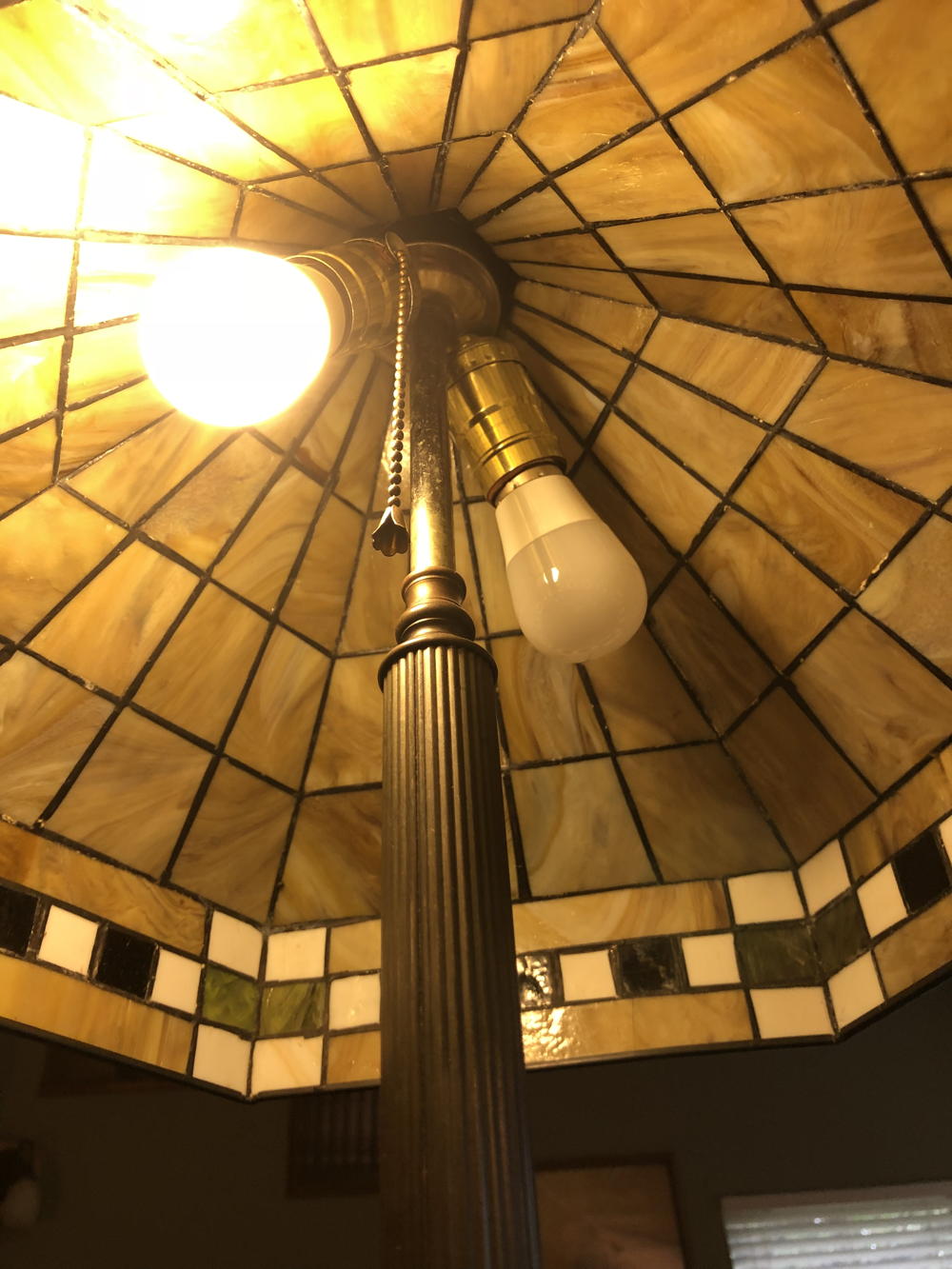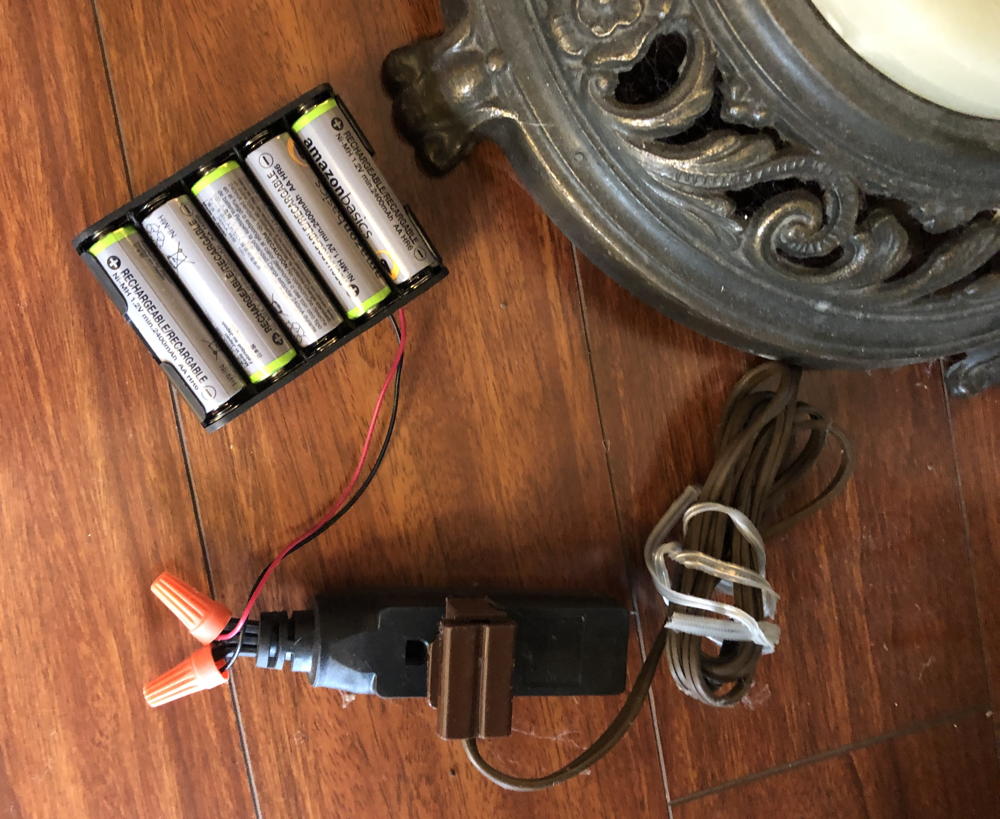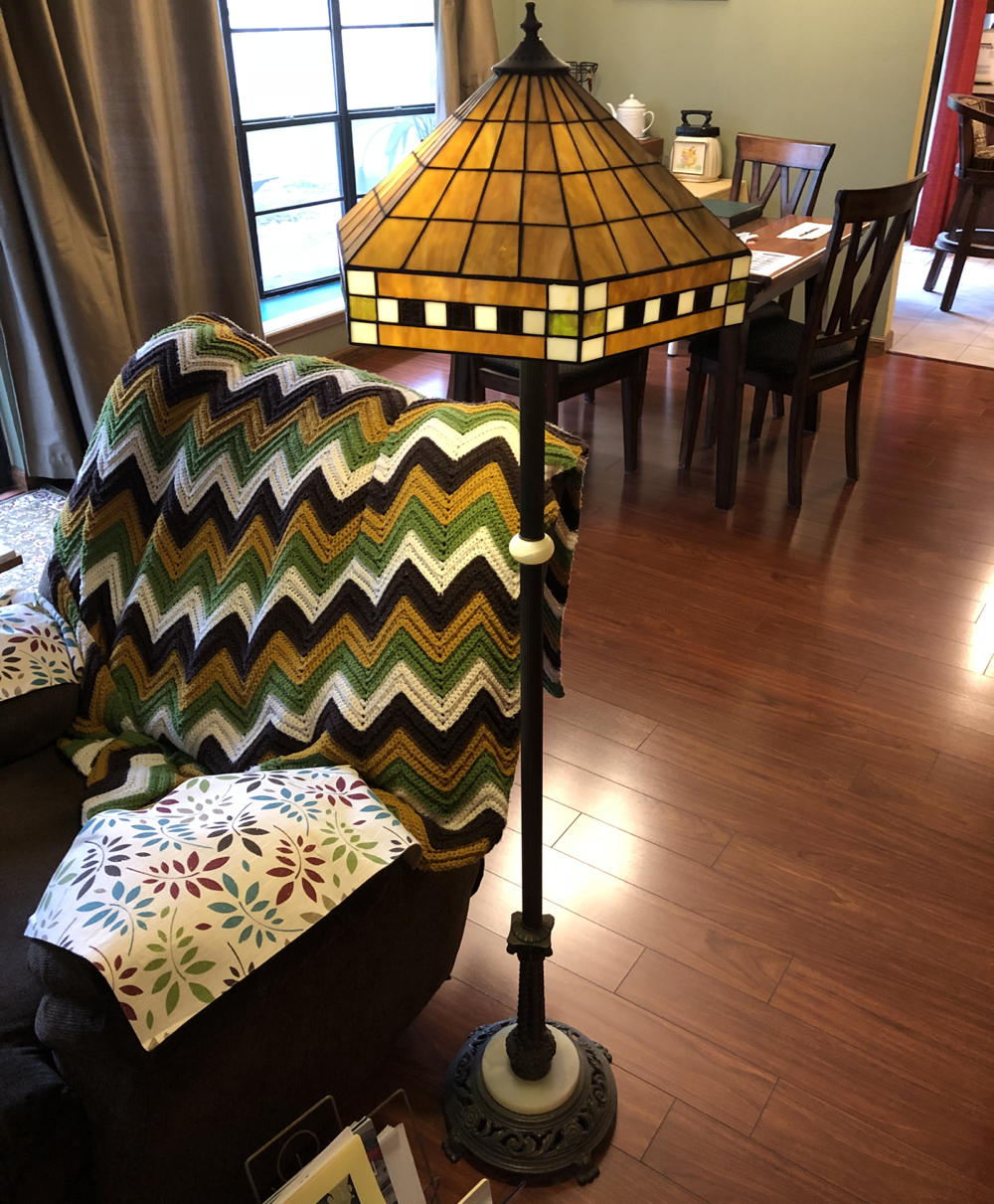Battery-operated floor lamp
A few years ago I bought a cheap recliner at Big Lots and placed it in the center of my living room, halfway between the bookshelf and the fireplace. There’s a nice large window behind it to the right. It’s a great place to sit back, relax, and read, except that at night the light reaching it is not enough for some of the smaller text in older books.1
I tried a couple of book light clip-ons I had lying around, and they were unsatisfactory. What I really needed was a good floor lamp. But there was no wall, and so no power outlet, that did not cross a walking route around the chair. My living room is half of one big room that comprises the living room and dining room. The great open space is nice, but the inability to put lamps in the middle, not so much.
Then, wandering the web for unrelated purposes, I happened across an article about turning desk lamps into battery-operated cordless lamps, because pretty much the worst way to set up a desk in any room is facing the wall.
Could I make a battery-operated floor lamp? Many campers use 12-volt DC to run their lights, and you can find LEDs that run on 12-volts DC and that have a standard light-bulb screw-on base.2
I originally tried an 8-battery pack, under the mistaken assumption that rechargeable batteries were one-to-one replacements for standard 1.5-volt batteries. Eight times 1.5 being 12 volts. But it turns out rechargeables are 1.2 volts. It worked, and lasted for a couple of weeks, but why not make one that lasts longer? So I found a ten-pack•—ten times 1.2 is 12 volts, after all—and that’s what I now use.

These small bulbs fit into standard 120-volt sockets, and provide enough light for reading at night. I only use one of the bulbs when reading.
In fact, ten times 1.2 turns out to be about 14 volts, as rechargeables seem to run at a higher voltage than they’re guaranteed at.
The light starts to dim once the voltage drops to about 10 volts, which takes about a month at my usage rate.
The lamp is extremely easy to convert, especially if you have half of an extension cord lying around. I did not alter the lamp itself at all. My original plan was to snip the cord on the lamp and tie it directly to the battery pack. Instead, I took the female end of an extension cord, and snipped that; tied it to the battery pack; and plugged the lamp into the battery pack.
This does run the risk of someone thinking it’s a normal floor lamp, and plugging it into a 120-volt wall outlet. This is likely to catastrophically destroy the 12-volt bulb(s) in the lamp. It’s a mistake that should only be possible while I’m charging the batteries. At any other time the person would have to unplug the lamp from the battery pack before plugging it into the wall.
The bigger danger is that, if you keep spare bulbs around, make sure to keep the spare 12-volt bulbs clearly labeled!
What makes this lamp possible is the extremely low power usage of LED bulbs. They use far less power than incandescent bulbs and last longer when running off of batteries.
The lower the wattage, the longer the battery pack will last between charges. Of course that also means the dimmer the bulb, but I am currently using a 4.5-watt LED bulb3 and it’s fine for night reading.
I recharge the batteries using a four-battery charger•, which means, for a ten-battery pack, I need to recharge in three separate sets.4 There’s no reason you couldn’t set up a recharger that trickles power directly into the battery pack. The main reason I haven’t done this is that I’m not sure how to provide feedback that the recharging has completed. The commercial recharger I use lights green when the batteries are ready. It also stops trickling power to the batteries at that point, which increases the life of the batteries.

The battery pack wires go into the female end of a snipped extension cord; the lamp plugs into the extension cord end without any modification. All of this hardware fits underneath the base of the lamp.
If you need the lamp to last longer between recharging, you need higher milliamp-hours (mAh) in your battery pack. The AA batteries I chose• are listed as 2400 mAh. Because I run them in serial, the battery pack is also 2400 mAh. I run them in serial because when you run batteries in serial, as most battery packs do, the voltages add up. The batteries are 1.2 volts, and so ten of them make 12 volts.
If I needed a longer time between charges, theoretically I could buy 2800 mAh or even 3000 mAh batteries. I say “theoretically” because recognizable brand names don’t appear to sell rechargeables at those capacities.
Another option would be to buy an extra set of ten batteries, an extra pack, and connect the two packs in parallel. When you connect batteries in parallel (and a battery pack is just like a single battery for purposes of this calculation), the voltage doesn’t increase but the amperage does.
“Serial” just means that they’re connected end to end, with the positive top of one battery connected to the negative bottom of the next battery. Parallel, for connecting battery packs to a lamp cord, means that you run a wire from the positive terminal on each battery pack to the same wire on the lamp cord.
You could also, if you have room in your lamp’s base, get bigger batteries. Tool batteries often run in the 3,000 to 4,000 mAh (3-4 Ah) or more.
Increasing the amperage shouldn’t hurt the bulb. It will pull what it needs, and since what it needs doesn’t change, a double battery pack will last twice as long between charges. Similarly for a tool battery. What matters is the voltage—12 volts in this case—and that the power be direct current, that is, from normal batteries.
Older eyes have nothing to do with it, I assure you.
↑The official name of the standard in the United States is E26; some will also say E27 as that’s the designation in Europe.
↑I can’t find anywhere online that has the 4.5-watt bulbs, and the ones I have do not list their lumen rating nor their wattage equivalent. Amazon thinks that these 5-watt bulbs• are the ones I ordered, which would make them 40-watt equivalents.
↑Battery chargers seem to assume that you’re always using a multiple of 4 batteries. I chose a four-charger for its size and price. A 12-charger would obviously be more convenient, but also obviously a lot bigger.
↑
- 10 AA Battery Clip Holder Box• at Amazon.com
- This battery holder box holds 10 AA batteries, four on the top and four on the bottom for a compact case. It easily fits under my lamp base. There are also long and low 10-AA boxes if you have more diameter and less height.
- AmazonBasics AA High-Capacity Batteries• at Amazon.com
- This package contains eight high-capacity rechargeable AA batteries. They’re rated at 1.2 volts, which is standard for rechargeables, and they’re 2400 mAh, which is fairly high for small batteries.
- AmazonBasics Ni-MH AA & AA Battery Charger• at Amazon.com
- This charger plugs directly into the wall and charges either two or four batteries at a time. It also can double as a USB power source.
- Chichinlighting 12-volt 5-watt E26 LEDs• at Amazon.com
- These 5-watt bulb/40-watt equivalent, if they’re the same ones I bought, are just about perfect for night reading.
- Lamp Hack: How to Make Any Lamp Cordless: Kelly
- “But if you’re not willing to compromise the room layout you want (and you want to appease the feng shui geeks), you can have your lamp and light it too… without the cord.”
More lights
- GU24 to Edison adapter
- The GU24 adapter for our hall light arrived from Amazon last week. It works great.
- GU24: Government-enforced energy-wasting lamps
- Government is trying to force us not to buy incandescents—and in the process, is forcing us to buy power-wasting bulbs.
More You Can Build That!
- Sealing the bread slice guide
- Charles the Simple suggested using “common mineral oil” to seal the wood. It works!
- National Sandwich Day: Do-it-yourself bread slice guide
- If you have a table saw or chop saw, making a bread slice guide is a snap.


